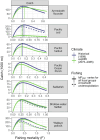Evaluating ecosystem caps on fishery yield in the context of climate stress and predation
- PMID: 40355390
- PMCID: PMC12069166
- DOI: 10.1002/eap.70036
Evaluating ecosystem caps on fishery yield in the context of climate stress and predation
Abstract
Ecosystem-based fisheries management strives to account for species interactions and ecosystem processes in natural resource management and conservation. In this context, ecosystem-wide caps on total fishery catches have been proposed as one tool to manage multispecies fisheries with an ecosystem approach. However, determining effective ecosystem caps is complicated because fish stock production is influenced by environmental conditions, species interactions, and fishing. Consequently, the implementation of ecosystem caps in fisheries management frameworks remains uncommon. We investigated whether ecosystem caps should account for climate variability and for predator-prey dynamics to achieve management objectives in complex marine ecosystems. We considered the example of the Gulf of Alaska (United States), a North Pacific large marine ecosystem where annual groundfish catches are managed using an "optimum yield" ecosystem cap of 800,000 t. We simulated multispecies yield of the 12 most abundant and commercially valuable groundfish stocks under selected climate and fishing scenarios using an end-to-end marine ecosystem model (Atlantis), which accounts for predator-prey and ecosystem dynamics. We found that total groundfish yield was never projected to exceed the 800,000 mt optimum yield cap across scenarios and fishing mortalities. Projected climate change led to decreased groundfish yield, and predation from the underexploited groundfish predator arrowtooth flounder (Atheresthes stomias) led to foregone catches. Groundfish removals had negative indirect effects on groundfish predators, despite total yield never exceeding the optimum yield cap, highlighting that an ineffective cap may not protect non-target species. These results suggest that the optimum yield cap currently used in the Gulf of Alaska may be too high to constrain groundfish catches under future climate change and low exploitation rates of predators. We propose that ecosystem caps should be reviewed when environmental conditions, stock productivity, or species interactions change.
Keywords: Atlantis; climate‐integrated modeling; ecosystem modeling; ecosystem‐based management; optimum yield; predator–prey dynamics.
© 2025 Commonwealth of Australian and The Author(s). Ecological Applications published by Wiley Periodicals LLC on behalf of The Ecological Society of America. This article has been contributed to by U.S. Government employees and their work is in the public domain in the USA.
Conflict of interest statement
The authors declare no conflicts of interest.
Figures







References
-
- Abelman, A. , Dalton M., Fissel B., Garber‐Yonts B., Kasperski S., Lee J., Lew D., et al. 2023. Stock Assessment and Fishery Evaluation Report for the Groundfish Fisheries of the Gulf of Alaska and Bering Sea/Aleutian Islands Area: Economic Status of the Groundfish Fisheries off Alaska, 2022. Aleutian Islands and Gulf of Alaska SAFE: NPFMC Bering Sea.
-
- Adams, G. D. , Holsman K. K., Barbeaux S. J., Dorn M. W., Ianelli J. N., Spies I., Stewart I. J., et al. 2022. “An Ensemble Approach to Understand Predation Mortality for Groundfish in the Gulf of Alaska.” Fisheries Research 251: 106303.
-
- Anderson, P. J. , and Piatt J. F.. 1999. “Community Reorganization in the Gulf of Alaska Following Ocean Climate Regime Shift.” Marine Ecology Progress Series 189: 117–123.
-
- Audzijonyte, A. , Pethybridge H., Porobic J., Gorton R., Kaplan I., and Fulton E.. 2019. “Atlantis: A Spatially Explicit End‐to‐End Marine Ecosystem Model with Dynamically Integrated Physics, Ecology and Socio‐Economics Modules.” Methods in Ecology and Evolution 10: 1814–1819.
MeSH terms
Grants and funding
LinkOut - more resources
Full Text Sources
Medical
Miscellaneous

